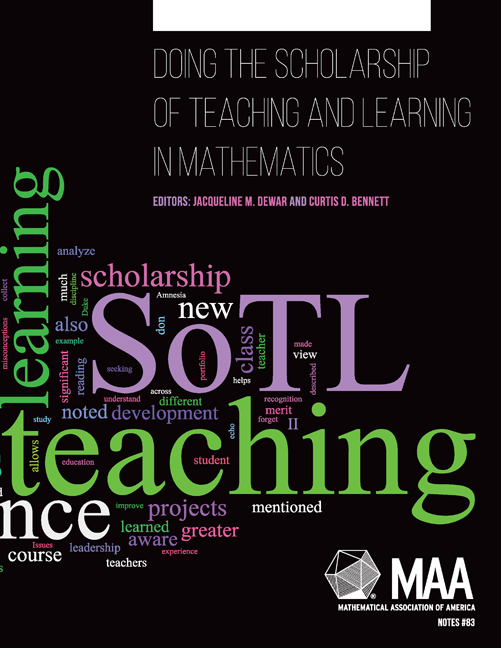Book contents
- Frontmatter
- Contents
- Foreword
- Preface
- Part I Getting Started in SoTL as a Mathematician
- Part II Illustrations of SoTL Work in Mathematics
- Theme 1: Experiments with Approaches to Teaching
- Theme 2: Crafting Learning Experiences around Real-World Data or Civic Engagement
- Theme 3: Using Assigned Reading Questions to Explore Student Understanding
- Theme 4: Exploring Student Understanding of the Nature of Mathematics
- 15 Liberal Arts Mathematics Students' Beliefs About the Nature of Mathematics: A Case Study in Survey Research
- 16 The Mathematics of Symmetry and Attitudes towards Mathematics
- 17 Mathematics Research Experiences for Preservice Teachers: Investigating the Impact on Their Beliefs
- Theme 5: Tackling Large Questions
- Epilogue
- Index
17 - Mathematics Research Experiences for Preservice Teachers: Investigating the Impact on Their Beliefs
from Theme 4: - Exploring Student Understanding of the Nature of Mathematics
- Frontmatter
- Contents
- Foreword
- Preface
- Part I Getting Started in SoTL as a Mathematician
- Part II Illustrations of SoTL Work in Mathematics
- Theme 1: Experiments with Approaches to Teaching
- Theme 2: Crafting Learning Experiences around Real-World Data or Civic Engagement
- Theme 3: Using Assigned Reading Questions to Explore Student Understanding
- Theme 4: Exploring Student Understanding of the Nature of Mathematics
- 15 Liberal Arts Mathematics Students' Beliefs About the Nature of Mathematics: A Case Study in Survey Research
- 16 The Mathematics of Symmetry and Attitudes towards Mathematics
- 17 Mathematics Research Experiences for Preservice Teachers: Investigating the Impact on Their Beliefs
- Theme 5: Tackling Large Questions
- Epilogue
- Index
Summary
Editors' Commentary
In this chapter a group at Illinois State University describe how they used the scholarship of teaching and learning to investigate whether having preservice teachers participate in a mathematical research experience for undergraduates (REU) program influenced their beliefs about teaching and learning mathematics. Unable to find an appropriate survey instrument, they developed their own. They explain the organization and content of the survey, tell how they piloted and tested it for reliability, and describe how the results are being used to improve the REU program.
Introduction
The Scholarship of Teaching and Learning (SoTL) can serve as a critical tool for improving instruction at the post-secondary level. If we, mathematicians and mathematics educators, can systematically explore, share, and reflect on our understanding of quality collegiate instruction, improvement in overall course quality and student learning can follow. The multifaceted nature of student learning presents a challenge for any educational study. One such facet is student beliefs. For example, an effective instructional strategy for teaching an honors calculus course for mathematics majors may not translate to a calculus course designed for business majors because of the different attitudes and beliefs of these two groups. Differences in students' views of the nature of mathematics, the importance of building mathematical understanding, the beauty of mathematics, or the standards for reasoning and proof, all can influence the success of instruction. In this chapter, we describe a SoTL study designed to inform and improve a mathematics education program that engages future secondary teachers in authentic mathematics research experiences. One of the goals of the program, the REU Site: Mathematics Research Experience for Pre-service and In-service Teachers (REU), is to change teachers' beliefs about mathematics and about the teaching and learning of mathematics and thus to influence the way they teach.
Impact of Beliefs on Secondary Mathematics Teachers
Numerous researchers have cited the impact of beliefs on teaching and learning (Ernest, 1989; Philipp, 2007; Schoenfeld, 1985; Silver, 1985; Thompson, 1992).
- Type
- Chapter
- Information
- Doing the Scholarship of Teaching and Learning in Mathematics , pp. 171 - 180Publisher: Mathematical Association of AmericaPrint publication year: 2014

